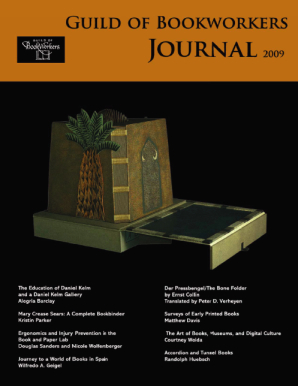What an odd-duck community we are: students and practitioners of the book crafts, devoted to a centuries-old technology and the arts that adorn and grow out of it, even as the twenty-first century’s information crackles through the very ether. New portals and modes of communication are burgeoning around us, and this Guild of Book Workers blog is one of them, offering us a new opportunity to increase our contact and conversation with each other, encouraging us to further exchanges of ideas.
Amid all this humming activity, what more bold communication experiment could we imagine than re-envisioning an actual print journal? A deliver-it-by-mail, pull-it-from-the-mailbox, hold-it-in-your-hands, turn-the-pages, good old-fashioned booklike sort of thing. It almost seems crazy. And yet, we’re committed to the physical book for a host of reasons, all of which are up for lots and lots of animated discussion of the old-fashioned sort (phone conversations) and the older-fashioned sort (letters) and the newfangled sort (online) and the oldest-fashioned sort of all (talking).
Here, on this blog, the newfangled joins hands with the classic. Any day now, Guild of Book Workers members will open their mailboxes and find a copy of the newly redesigned, reconceived Journal. (Not a member? Order a copy here, or better still, join here!) Look at it, read it at your leisure, mull it over, then discuss it. That’s the best part of the experiment: It doesn’t end with the printed page. It only begins there. It continues here with your comments. Future posts will invite conversation about particular articles; right now we want to hear anything and everything you have to say about this issue.
Cara Schlesinger, Editor
 Table of Contents
Table of Contents
The Education of Daniel Kelm / by Alegria Barclay, with a gallery of bindings and artist’s books by Daniel Kelm
Daniel Kelm is best known for his innovative and thought-provoking artist books. However, he is as talented a teacher as he is an artist. And as a man of myriad talents, he has devoted his life to sharing his passion with others.
Mary Crease Sears: A Complete Bookbinder / by Kristin Parker
Mary Crease Sears was a Boston bookbinder, active from about 1900, taking commissions until her death in 1938. Almost nothing has been written about her in the surveys about bookbinding history in America. Attention was paid to women bookbinders through the annual Expositions held in various cities, implying that bookbinding at the turn of the century straddled the line between fine art and industry. Do we know little about Sears because she chose to concentrate on individual commissions, rather than publishers bindings, which were produced in quantity?
Ergonomics and Injury Prevention in the Book and Paper Lab / by Douglas Sanders and Nicole Wolfersberger
Book and paper conservators complete their work with small and precise tools performing detailed, repetitive tasks. The tools are tailored to the job, rather than to the physical needs of the worker. This, combined with problematic workspace and poor posture and work habits, may contribute to repetitive strain injuries that, if left unchecked, can become more and more serious with time. But the causes of repetitive strain injuries in the book and paper lab can be identified, and the effects can be curbed.
The Pilgrimage: Journey to a World of Books in Spain / by Wilfredo A. Geigel
Serious bibliophiles or booklovers should travel to Spain for a visit to its archives and libraries at least once in their lifetime with no less devotion than that of the Muslims in their required visit to Mecca as prescribed by Islamic law. The trove of magnificent manuscripts and printed works preserved in the Spanish institutions is emblematic of the artistic and cultural richness of the Iberian Peninsula, a feat that is difficult to equate or surpass by many other countries.
Der Pressbengel/The Bone Folder: A Dialogue Between an Aesthetically-Inclined Bibliophile and a Well-Versed-In-All-Aspects-of-the-Craft Bookbinder by Ernst Collin / Translated and introduced by Peter D. Verheyen
Der Pressbengel, by Ernst Collin, was originally published in German in 1922. This is its first translation into English. Conceived as a dialogue between a bibliophile and a master bookbinder on all aspects of the bookbinding craft as well as specific techniques, the text also addresses the conflicts between quality and cost and matters of good taste. An introduction by the translator discusses the historical context of the decline of formal training, a trend that continues today.
Where Does the Catalog Go? Surveys of Old Printed Books, What We Can Learn from Them, and Why They Matter / by Matthew Davis
There is a danger in approaching electronic versions of early printed texts in the same way we might a modern text: Early hand-printed books often contained multiple errors that were corrected throughout the print run. If these works are digitized, readers and scholars may run the risk of mistaking any single electronic version as authoritative. The case of the 1679 Works of that Famous English Poet, Mr. Edmund Spenser shows why comparison of the errors in all available copies of a text is necessary before authoritative status can be determined.
Exploring the Book(Cases): The Art of Books, Museums, and Digital Culture / by Courtney Weida
Artists’ books are a unique metaphorical threshold between text/narrative and image/object with rich poetic, visual, and tactile content. Within the context of a museum, these handcrafted and handheld artifacts of material culture offer a window into the potentialities and problems of the book arts, particularly in the overlapping contexts of digital culture.
Accordion and Tunnel Books: Twenty Years of Exploration and Constructing a Tunnel Book / by Randolph Huebsch
Accordion and tunnel books are centuries-old structures whose basic simplicity allows for wide and playful experimentation. Book artists are increasingly exploring these forms, drawing on methods from etching to cut paper to photocopying and beyond, and ranging in size from a single sheet of paper to larger-than-life interactive sculptural works. The possibilities arising from the combination of panels, accordion strips, and hinges are endless.